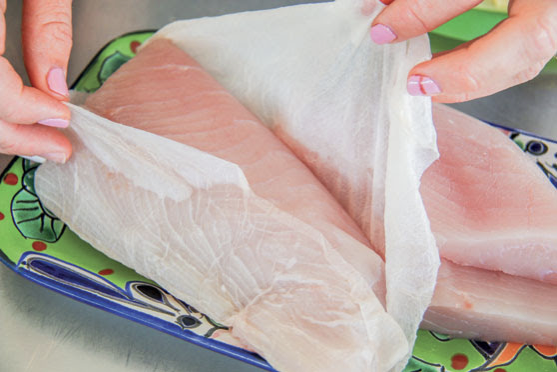No question is silly - we learn from everything we ask about!

QUESTION:
This is probably a silly question, but I am new to cooking since pandemic and from research learned that when I defrost meat or chicken or fish from the freezer-after thawing to wrap the item in a towel to get to room temp and become drier. Then salt or use seasoning before cooking. There are many instances in which raw food debris sticks to the towel and washing them has not been effective and I’ve been throwing them out. I’m running out of old towels; any suggestions or should I just buy a set of cheap towels and keep throwing them away?
Thank you in advance for help ~ Eric G.
ANSWER:
Hi Eric, No question is silly - we learn from everything we ask about!
Although I haven't tried it, I think using a muslin cloth to pat the meat dry would be a good solution. It's a nice, clean material, with little to no loss of fibers ("hairs", "fluff", don't know what term to use exactly) than a kitchen towel, and I imagine it would still get the job done.
To clean it, you would have to put it in boiling water, and (perhaps?) add a drop of bleach to it, so it's sterilized again. A good quality muslin will have plenty of life in it, and take quite a lot of abuse (including cooking, and using it as a wringer for squeezing out fluids).
I have also heard Brown Paper lunch bags will dry your meat. Crumple it first to soften. Even better, place the chicken, beef, fish in the bags and press lightly.
Also, I found this article below on a Fishing website I follow and thot it to be very appropriate for you too:
Many people consider freezing fish to be sacrilege, but done right, the results are pretty good.
Earlier this year, when fishing in Hawaii, we caught a nice yellowfin tuna. While taking the fillets off, the first mate Kevin H. was wrapping each individual slab in paper towels before placing them in a zip-lock bag.
My initial thought was, ‘What a waste of time and paper towels!’ However, as I knew Kevin is a very experienced fisherman, and caring for and getting the best from my catch is very important to me and my family; I just had to ask the question: “Why are you doing this, Kevin?”
The reply was to change the way I care for our fish fillets.
“Wrapping the slabs of fish in paper towels stops the fillets getting slimy. It draws out the excess moisture, keeps the meat tasting fresher, and extends the life in the refrigerator.” ‘Hmmm,’ I thought, ‘sounds like a good idea – I’m going to try this back in New Zealand on our snapper and kingfish.’
This happened at the beginning of my adventure in Kona, and I had a bunch of mates and clients arriving over the next eight days; I knew they would be hanging out for some yellowfin sushi, steaks and tuna cakes, so I wanted to keep this fish in the best possible shape.
I remember getting back to my house that night with a massive bag of yellowfin slabs all wrapped in paper towels. First, I carefully took a nice slab, removed the paper towels, and immediately noticed how dry, shiny and fresh it looked (understandable given it was caught that day, but still looking better than if just thrown into a bag with the other fillets).
Next, I rewrapped this prized slab in clean paper towels, put it in a zip-lock bag, sucked the air out and placed it in the freezer, pending my friend’s arrival in eight days’ time. Normally, freezing a nice slab of yellowfin or bluefin tuna is a crime, but it was a case of necessity this time – and it also provided a great opportunity for worthwhile experimentation.
Over the next four days we ate yellowfin tuna every night. Each time we unwrapped a fillet, it was dry, had a fresh pearl-pink colour and never had a smelly fish odour. Impressed? Hell yes!
But the ultimate test was coming. Eight days after the fish had been caught, my good friend arrived, and it was time to put my new-found fish-keeping strategy to the test.
After pulling the tuna slab from the freezer, I thawed it out; Bea would be cooking it for him that night, and I was eager to get some feedback.
Inspecting the thawed-out slab, it did not look as if it had been frozen, and upon cutting the block of tuna in half, it still had that shiny, clean look of a fresh fillet. The feedback was excellent, and our man was very happy to be eating ‘fresh’ yellowfin tuna.
This experience prompted me to check how expensive tuna slabs were looked after in restaurants. I noticed they, too, were often wrapped in paper towels or cloth to ensure the best quality and extend their shelf life.
I hope all that helps you and do keep on Cook'n Eric!
